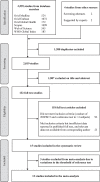The 20-minute whole blood clotting test (20WBCT) for snakebite coagulopathy-A systematic review and meta-analysis of diagnostic test accuracy
- PMID: 34375338
- PMCID: PMC8405032
- DOI: 10.1371/journal.pntd.0009657
The 20-minute whole blood clotting test (20WBCT) for snakebite coagulopathy-A systematic review and meta-analysis of diagnostic test accuracy
Erratum in
-
Correction: The 20-minute whole blood clotting test (20WBCT) for snakebite coagulopathy-A systematic review and meta-analysis of diagnostic test accuracy.PLoS Negl Trop Dis. 2023 Jan 24;17(1):e0011080. doi: 10.1371/journal.pntd.0011080. eCollection 2023 Jan. PLoS Negl Trop Dis. 2023. PMID: 36693087 Free PMC article.
Abstract
Background: The 20-minute whole blood clotting test (20WBCT) has been used to detect coagulopathy following snakebite for almost 50 years. A systematic review and meta-analysis of the 20WBCT was conducted to evaluate the accuracy of the 20WBCT to detect coagulopathy, indicative of systemic envenoming.
Methods and findings: Databases were searched from inception up to 09/12/2020 to identify studies that compared the 20WBCT and INR/fibrinogen on five or more subjects. Data was extracted from full-text articles by two reviewers using a predetermined form. Authors of 29 studies that lacked sufficient details in the manuscript were contacted and included if data meeting the inclusion criteria were provided. Included studies were evaluated for bias using a tailored QUADAS-2 checklist. The study protocol was prospectively registered on PROSPERO database (CRD42020168953). The searches identified 3,599 studies, 15 met the inclusion criteria and 12 were included in the meta-analysis. Data was reported from 6 countries and included a total of 2,270 patients. The aggregate weighted sensitivity of the 20WBCT at detecting INR >1.4 was 0.84 (CI 0.61 to 0.94), the specificity was 0.91 (0.76 to 0.97) and the SROC AUC was 0.94 (CI 0.91 to 0.96). The aggregate weighted sensitivity of the 20WBCT at detecting fibrinogen <100 mg/dL was 0.72 (CI 0.58 to 0.83), the specificity was 0.94 (CI 0.88 to 0.98) and the SROC AUC was 0.93 (0.91 to 0.95). Both analyses that used INR and fibrinogen as the reference test displayed considerable heterogeneity.
Conclusions: In the absence of laboratory clotting assays, the 20WBCT remains a highly specific and fairly sensitive bedside test at detecting coagulopathy following snakebite. However, clinicians should be aware of the importance of operator training, standardized equipment and the lower sensitivity of the 20WBCT at detecting mild coagulopathy and resolution of coagulopathy following antivenom.
Conflict of interest statement
The authors have declared that no competing interests exist.
Figures








References
-
- Abubakar IS, Abubakar SB, Habib AG, Nasidi A, Durfa N, Yusuf PO, et al.. Randomised controlled double-blind non-inferiority trial of two antivenoms for saw-scaled or carpet viper (Echis ocellatus) envenoming in Nigeria. PLoS Negl Trop Dis. 2010;4(7):e767. doi: 10.1371/journal.pntd.0000767 - DOI - PMC - PubMed
-
- Warrell DA, Davidson N, Greenwood BM, Ormerod LD, Pope HM, Watkins BJ, et al.. Poisoning by bites of the saw-scaled or carpet viper (Echis carinatus) in Nigeria. Q J Med. 1977;46(181):33–62. - PubMed
Publication types
MeSH terms
Substances
Grants and funding
LinkOut - more resources
Full Text Sources
Miscellaneous

